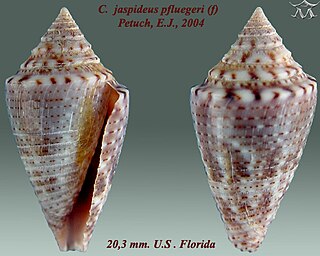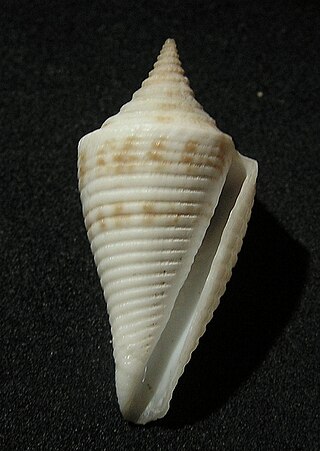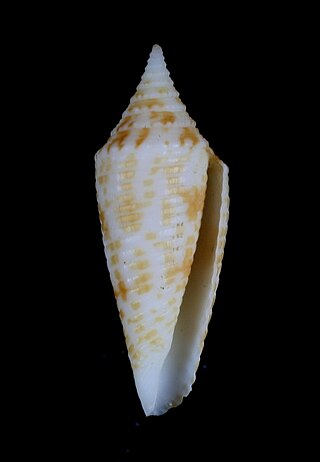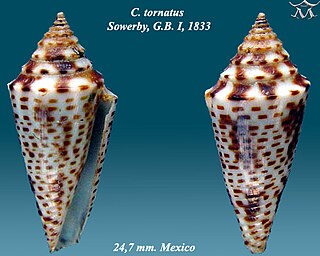
Jaspidiconus is a subgenus of sea snails, marine gastropod mollusks in the genus Conasprella, family Conidae, the cone snails and their allies.

Calamiconus is a subgenus of sea snails, marine gastropod mollusks in the genus Conus, family Conidae, the cone snails and their allies.

Calibanus is a subgenus of sea snails, cone snails, marine gastropod mollusks in the genus Conus, family Conidae, the cone snails and their allies.

Californiconus is a genus of sea snails, marine gastropod mollusks. The experts at WoRMS place this group of species in the family Conidae, the cone snails, but some other experts placed previously the genus in a proposed family, the Conilithidae. This is a monotypic genus.

Conasprelloides is a subgenus of sea snails, marine gastropod mollusks in the family Conidae, the cone snails and their allies.

Dalliconus is a subgenus of sea snails, marine gastropod mollusks in the genus Conasprella, family Conidae, the cone snails and their allies.

Dendroconus is a subgenus of sea snails, marine gastropod mollusks in the genus Conus, family Conidae, the cone snails and their allies.

Endemoconus is subgenus of sea snails, marine gastropod mollusks in the genus Conasprella, family Conidae, the cone snails and their allies.

Eremiconus is a subgenus of sea snails, marine gastropod mollusks in the genus Conus, family Conidae, the cone snails and their allies.

Eugeniconus is a subgenus of sea snails, marine gastropod mollusks in the genus Conus, family Conidae, the cone snails and their allies.

Conilithidae is a proposed taxonomic family of small to medium-sized sea snails, specifically cone snails, marine gastropod mollusks in the superfamily Conoidea, the cone snails and their allies.

Fusiconus is a subgenus of sea snails, marine gastropod mollusks in the genus Conasprella, family Conidae, the cone snails and their allies.

Gladioconus is a synonym of a subgenus of sea snails, marine gastropod mollusks in the genus Conus, family Conidae, the cone snails and their allies. T

Globiconus is a subgenus of sea snails, marine gastropod mollusks in the genus Conasprella, family Conidae, the cone snails and their allies.

Gradiconus is a synonym of a subgenus of sea snails, marine gastropod mollusks in the genus Conus, family Conidae, the cone snails and their allies. T

Kohniconus is a subgenus of sea snails, marine gastropod mollusks in the genus Conasprella, family Conilithidae, the cone snails and their allies.

Lilliconus is subgenus of sea snails, marine gastropod mollusks in the genus Conasprella, family Conidae, the cone snails and their allies.

Nataliconus has become a synonym of the subgenus Conus (Leptoconus)Swainson, 1840 represented as ConusLinnaeus, 1758as stated the latest classification of the family Conidae by Puillandre N., Duda T.F., Meyer C., Olivera B.M. & Bouchet P. (2015).

Parviconus is a subgenus of sea snails, marine gastropod mollusks in the genus Conasprella, family Conidae, the cone snails and their allies. This genus currently is still treated by some experts as an "alternative representation" of this group of species.

Perplexiconus has become a synonym of Conasprella (Ximeniconus) Emerson & Old, 1962, a subgenus of sea snails, marine gastropod mollusks in the family Conidae, the cone snails and their allies.



















